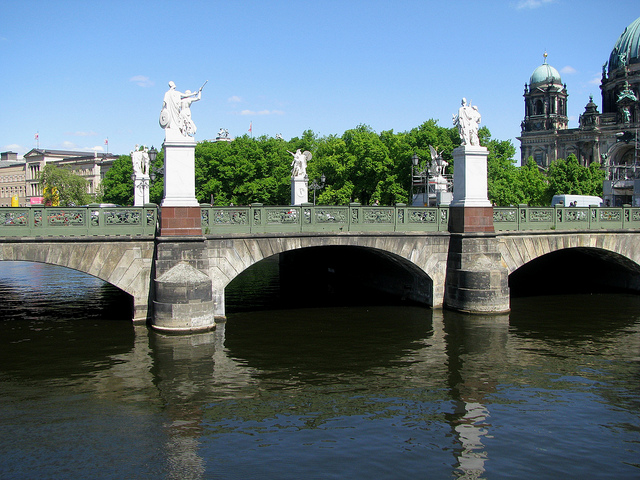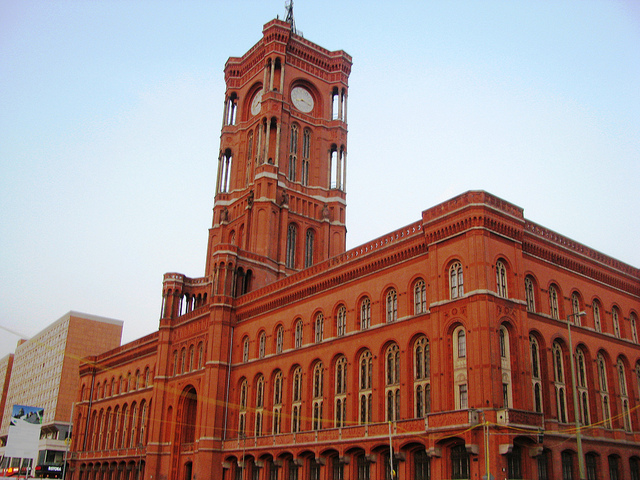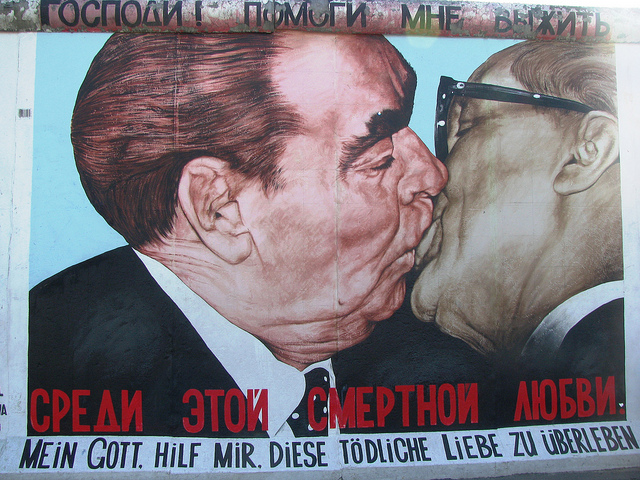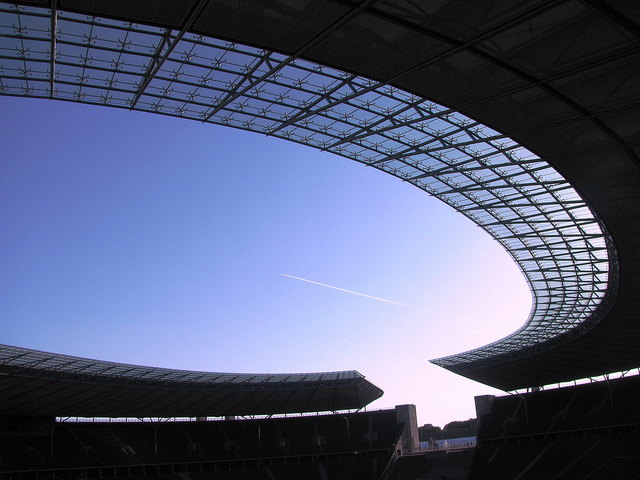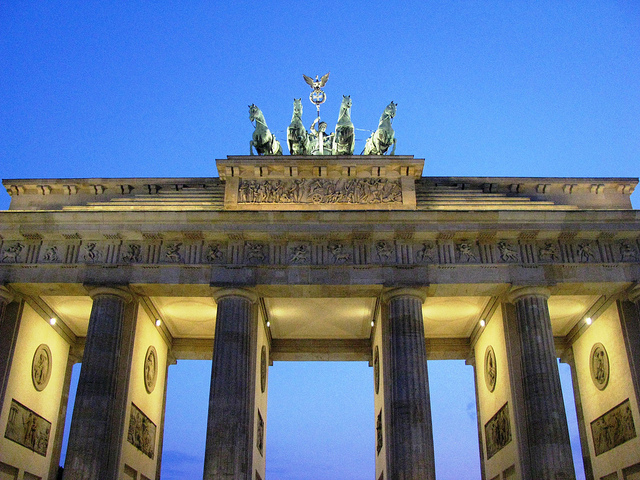May 3, 2011 – my final day in Berlin – had another real highlight in store for me: a guided bicycle tour with Judy Anderssen from Berlin on Bike. Judy is one of the many young people who have come to Berlin from other parts of Germany and fallen in love with the city. In the mid morning we headed out to Kreuzberg, Judy’s favourite Berlin district, and one of the city’s coolest and most artsy neighbourhoods. Formerly a run-down neighbourhood next to the hated Berlin Wall, it has become a hotbed of arts, culture and entertainment. Kreuzberg is also home to many immigrants, many of whom have Turkish ancestry.
Judy showed me some of her favourite spots: we first stopped the Sophienfriedhof cemetery close to the Zionskirche (Zion Church). Shards of glass still adorn the top of the cemetery wall, a left-over reminder of this graveyard’s proximity to the former location of the Berlin Wall. The Zionskirche gained importance as it was home to pastor Dietrich Bonhoeffer who was a well known resistance fighter against the Nazis and involved in a plot to assassinate Adolf Hitler. He was arrested and hanged in April of 1945 in a German concentration camp.

We continued cycling and then, not far away, we stopped at a small neighbourhood Holocaust memorial on Koppenplatz. Called “the Lonesome Room”, this memorial features a table, one upright and one turned-over chair, and symbolizes the moment when a Jewish family would have been captured and deported. The memorial is very poignant in its simplicity and captures the implicit dread of this scenario perfectly. The surrounding district was home to a large number of Jewish residents who perished during the Holocaust.
We continued on to Berlin’s famous Hackesche Höfe, the city’s most well-known courtyard complex which features eight interconnected courtyards. Built in the Art Nouveau Style, the buildings hold residential, commercial and retail units. The most famous courtyard features a magnificent facade of multi-coloured glazed brick. Today, we had a look at a non-renovated courtyard which provided a great example of what this complex would have looked like during East German times. Everything was grey and brown, the stucco was crumbling and graffiti adorned all the walls.

Judy pointed out the Otto Weidt Workshop for the Blind and Deaf, a special workshop where owner Otto Weidt fought to protect his Jewish workers against deportations in the early 1940s. About 30 deaf and blind Jewish people worked here, producing brooms for the Nazi military and Weidt was able to save some of them from deportation. After WWII Otto Weidt dedicated himself to building a Jewish Orphanage and a seniors’ home for concentration camp survivors. He was posthumously honoured as a “Righteous Man of the World’s Nations”.
At one of the entrances to the Hackesche Höfe, Judy also pointed out some examples of “Stolpersteine” – special brass-covered paving stones that commemorate Jewish families that became victims of the Holocaust. We saw memorial stones for the entire Schneebaum family, a couple and two young children, who were deported from this complex in 1943 to Auschwitz and perished in the Holocaust. I found it amazing that Berlin confronts itself with some of this horrific past and actually commemorates many of the terrible events that occurred in this city during WWII.

After we crossed the Spree River, we stopped at the “Treehouse by the Wall” – a simple structure built by Osman Kalin, a Turkish immigrant, on former East Berlin territory on the West Berlin side of the Wall starting in 1983. The GDR government had decided to cut corners while building the Berlin Wall which left a small portion of East Berlin land on the western side of the wall. When Osman saw this unused piece of land, he started to use it to plant vegetables and to build a tree house from various unused materials. Since 1989 Osman Kalin considers this place his home and still continues his guerilla gardening. And his unusual abode has actually become a tourist attraction.
Finally we had made our way into Kreuzberg, Judy’s most favourite district in all of Berlin. She explained to me that this district is home to a colourful arts scene, and although it is being gentrified, it is still pleasantly rough around the edges. Her favourite Italian restaurant and a treasured ice cream store are just minutes from Heinrichplatz, the square where we had stopped. Turkish supermarkets are all over the place, and food and other goods can be purchased inexpensively. Judy added that, just a couple of days ago, the square was packed for the May Day festivities, the so-called “Myfest”, a street festival that includes a large cultural and culinary program. This festival has gone a long way towards reducing the traditional May Day riots that take place in Berlin’s Kreuzberg district every year.

We continued through a nice historic neighbourhood until we stopped at a concrete housing development named Kottbusser Tor. Judy explained that this area is experiencing a number of social problems, including drug-related crime. Compared to the attractive multi-storey rental buildings in the area, this brutalist housing complex stood out in its stark concrete utilitarianism. I learned that the area is a “sozialer Brennpunkt” (a problem district with many social issues) and is host to some of Berlin’s annual May Day riots. About 80% of local residents are of non-German origin and the area has been designated a neighbourhood with special needs due to high unemployment, low incomes and various types of crime.
In the warm mid-day sun we continued our cycling trip beside the gorgeous Landwehrkanal – a beautiful river channel , and stopped at the former Görlitzer Bahnhof train station that has been turned into a beautiful park. Judy added that during the May Day Festival, this park was so packed with people that it was difficult to even walk through here. Minutes away we stopped for a nice lunch with Lebanese food. Judy knew the owners well and is a regular customer at this small restaurant. Kreuzberg is full of multicultural delights.

Towards the end of our tour we saw the St. Michaelskirche – a ruined church with an intact front and back facade whose central portion was destroyed by bombs in February of 1945. I had to wrap my head around another one of these admonishing building fragments that remind locals and visitors alike of Berlin’s gruesome World War II history. No matter where you step in Berlin, 20th century history will be in your face. Right in front of the church was the former death strip of the Berlin Wall that separated East from West Berlin. Today, the death strip has been turned into an urban park.
After a brief stop on a bridge overlooking the Spree River, my bicycle tour of Kreuzberg had come to an end. The two bike tours I had taken in Berlin had become a definite highlight of the trip and learning about the city from local expert Judy helped me understand this unique metropolis so much better.

